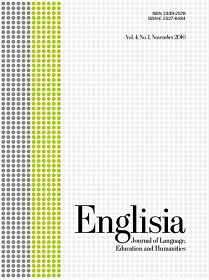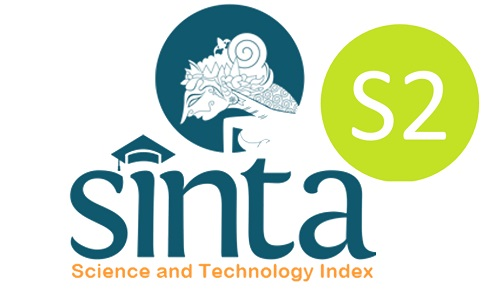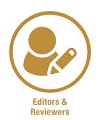TEACHING METHODS USED BY STUDENTS OF DEPARTMENT OF ENGLISH LANGUAGE EDUCATION OF UIN AR-RANIRY IN TEACHING ENGLISH AT ENGLISH COURSE
DOI:
https://doi.org/10.22373/ej.v4i1.1023Keywords:
Teaching grammar, English courses, teaching method, techniquesAbstract
Learning can take place in school, course, and community. There are some differences of teaching at school and course, such as teaching methods used. It is one of the most important elements in teaching. Teaching method is used to help the learners to gain the knowledge and help them to achieve their learning targets. Therefore, this research focused on teaching methods that were used by English Education Department students in UIN Ar-Raniry in teaching grammar at English courses. The purposes of this research were to identify which methods were used in teaching grammar at courses and to describe the teaching techniques that were applied in classroom. The participants were five English Education students who have been teaching English at English courses. They were selected using purposive sampling with a consideration that they have completed Teaching Method, Micro Teaching, and Teaching Practice (PPL) subjects in their previous semesters. This research was conducted by using qualitative descriptive and two techniques for collecting data namely observation and interview. Based on the research findings, writer found that all of the selected teachers used Grammar Translation Method (GTM) as the main teaching method which was sometimes combined with some techniques of other methods such as Direct Method, Communicative Language Teaching (CLT), and Bilingual Method.Downloads
References
Aiiulistya. (2013). The Bilingual Method.
Appefiled, J. M., Huber, R., & Moallem, M. (2001) Constructivism in Theory and Practice: Toward A Better Understanding. University of North California Wilmington.
Brown, H. D. (2000). Teaching by Principles. California: Longman.
Daniel W, T., III. (2010). Qualitative Interview Design: A Practical Guide for Nvice Investigators. The Qualitative Report, 15(3), 754.
Driscoll, D. L. (2011). Introduction to Primary Research: Observations, Surveys, and Interviews. Handbook : Writing Spaces: Readings on Writings 2.
Dykes, B. (2007). Grammar for Everyone, Practical Tools for Learning and Teaching Grammar. Victorias: ACER Press.
Edisherashvili, N. (2014). Communicative Language Teaching in Georgia: Froem Theory to Practice. Leiden University.
Guun, V. (2007). Approaches to Small Group Teaching and Learning.
Hanlon, B., & Larget, B. (2011). Samples and Populations.
Harmer, J. (Ed.). (2007). The Practice of English Language Teaching. Cambridge, UK: Pearson Longman.
Kawulich, B. B. (2005). Participant Observation as a Data Collection Method. Forum: Qualitative Social Research, 6(2).
Khamhuber, P. (2010). Comparison of Grammar in Australia and Spanish English Language Teaching Textbook. Magister der Philosophy, University of Wien.
Khan, R. N. (2007). Effective Grammar Teaching in EFL Classroom. Bachelor of Arts in English, BRAC University, Bangladesh.
Knupfer, N. N., & McLellan, H. (1996). Descriptive Research Methodologies. Research Methodologies and Educational Communication and Technology, 7.
Kvale, S. (1996). Interviews: An Introduction to Qualitative Research Interviewing. Thousand Oaks California: Sage Publications.
Latham, B. (2007). Sampling: What Is It? Quantitative Research Methods.
Mart, C. T. (2013). The Grammar Translation Method and The Use of Translation to Facilitate Learning in ESL Classes. Advances in English Language Teaching, 1(4), 103-105.
McKay, S. L. (2008). Researching Second Language Classrooms. New Jersey, London: Lawence Erlbaum Associates Published.
Oliver, P. (2006). Purposive Sampling. SAGE Reserach Methods.
Palys, T. (2008). Purposive Sampling. The Sage Encyclopedia of Qualitative Research Method, 2, 697.
Pasassung, N. (2003). Teaching English in an: "Acquisition-Poor Environemnt: An Ethnography Example of Remote Indonesian EFL Classroom. Doctor Philosophy, University of Sydney.
Patel, D. M. F., & Jain, P. M. (2008). English Language Teaching (Method, Tools, and Techniques). Jaipur: Sunrise Publisher.
Quinn, M., & Cochran, M. (2002). Guide to Using Qualitatie Researc Methodology.Medicines Sans Frontier.
Rahman, M. (2012). Grammar Translation Method (GTM): An Effective and Feasible Method in Bangladesh Context. Bachelor BRAC University, Bangladesh.
Sanjaya, H. W. (2013). Penelitian Pendidikan : Jenis, Metode, dan Prosedur. Jakarta: Kencana Prenada Media Group.
Shejbalova, D. (2006). Methods and Approaches in Vocabulary Teaching and Their Influence in Students' Acquicitions. Masaryk University.
Surgenor, P. (2010). Large and Small Group Teaching. UCD Dublin.
Vin-Mbah, F. I. (2012). Learning and Teaching Methodology :What Teacher Should Know and Should Able to Do. Journal of Educational and Social Research, 2(4).
Vongxay, H. (2013). The Implementation of Communicative Language Teaching (CLT) in An English Department In A Lao Higher Educational Institution: A Case Study. Master, Unitec Institution of Technology, New Zealand.
Walliman, N. (2001). Your Research Project: a step-by-step Guide For The First Time Researcher. London: Sage Publication.
Downloads
Published
Issue
Section
License
Proposed Policy for Journals That Offer Open Access
Authors who publish with Englisia journal agree to the following terms:
- Authors retain copyright and grant the journal right of first publication with the work simultaneously licensed under a Creative Commons Attribution License that allows others to share the work with an acknowledgement of the work's authorship and initial publication in this journal.
- Authors are able to enter into separate, additional contractual arrangements for the non-exclusive distribution of the journal's published version of the work (e.g., post it to an institutional repository or publish it in a book), with an acknowledgement of its initial publication in this journal.
- Authors are permitted and encouraged to post their work online (e.g., in institutional repositories or on their website) prior to and during the submission process, as it can lead to productive exchanges, as well as earlier and greater citation of published work (See The Effect of Open Access).









